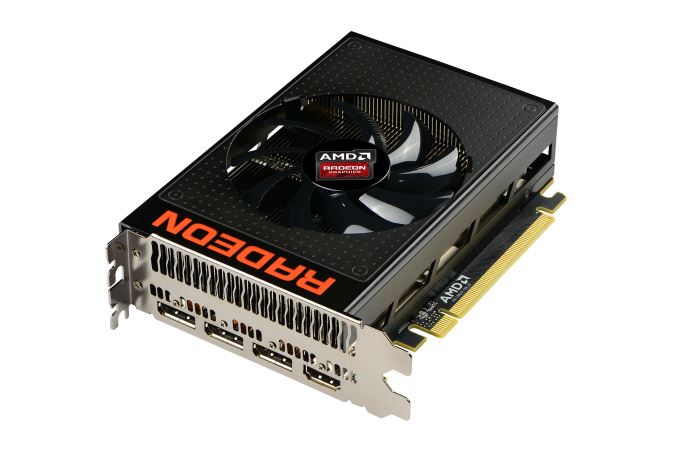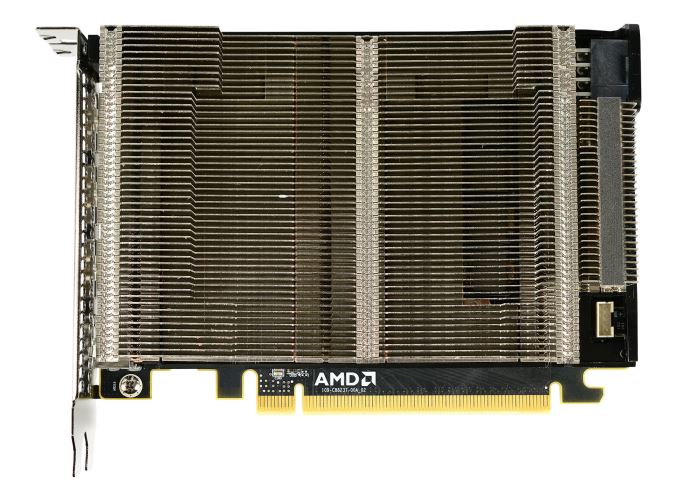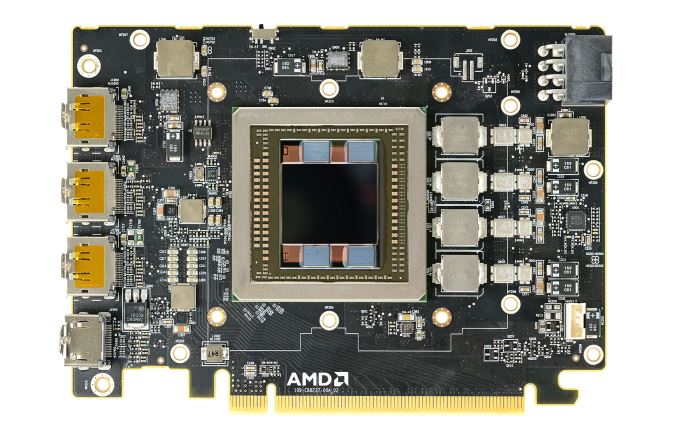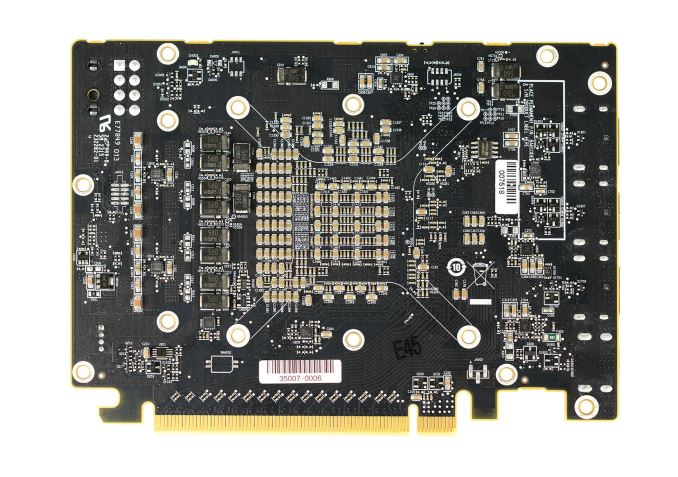The AMD Radeon R9 Nano Review: The Power of Size
by Ryan Smith on September 10, 2015 8:00 AM ESTMeet The Radeon R9 Nano
6 inch video cards are by no means a new thing in the GPU space, however these are traditionally lower-end products that need neither a large cooler nor an extensive power delivery system. As a result the R9 Nano is something of an interesting aberration, packing a lot more power and a lot more technology into half a foot of video card than what we normally see.
Starting as always from the top, the R9 Nano measures 6” long, which is actually a bit shorter than the full length the Mini-ITX standard allows. Responsibility for cooling the card falls to the R9 Nano’s new open air cooler, an aggressive design that has been specifically tailored to allow the card to effectively dissipate 175W of heat in such a small space.
The overall design of the R9 Nano’s cooler is best described as a combination open-air and half-blower hybrid. The design is technically open-air, employing a single axial fan to cool the card. However with only a single fan AMD has been able to align the heatsink fins horizontally and then place the fan in the center of the heatsink. The end result is that roughly half of the heat produced by the card is vented outside of the case, similar to a full blower, while the other half of the heat is vented back into the case. This reduces (though doesn’t eliminate) the amount of hot air being recycled by the card.
The heatsink itself is composed of aluminum and runs virtually the entire length of the card. This is technical a two-piece heatsink, with the primary heatsink composing the bulk of the card, while a much smaller secondary heatsink it found towards the far end of the card and mounted on top of a heatpipe.
Drilling down, we find that the primary heatsink is fed by a combination vapor chamber and heatpipe design. A copper vapor chamber serves to draw heat away from the Fiji GPU and HBM stacks, and then heatpipes are used to better distribute heat to the rest of the heatsink. The use of a vapor chamber in the R9 Nano makes a lot of sense given the fact that vapor chambers are traditionally the most efficient heatsink base type, however the R9 Nano is also unique in that we typically don’t see vapor chambers and heatpipes used together. Other designs such as the high-end GeForce series use a single large vapor chamber across the entire heatsink base, so among reference cards at least the R9 Nano stands alone in this respect. In this case given AMD’s design goals for size and noise, a vapor chamber will play a big part in helping the small card effectively and quietly dissipate 175W.
As for the physical PCB itself, as we can see AMD made it a relatively packed card in order to get the R9 Nano down to 6 inches. Compared to the R9 Fury X reference board, the biggest change here is that AMD has removed a fair bit of power circuitry to save space. By our count there are 4 VRM phases to feed the Fiji GPU, as opposed to the 6 found on R9 Fury X. Power delivery is handled by a single 8-pin PCIe power socket, which is becoming increasingly common, replacing the 2x 6-pin setup for 150W-225W cards.
Meanwhile to further shrink the overall PCB footprint, AMD has moved some of the remaining power delivery circuitry to the back of the card. The front of the card still contains the inductors and heat-sensitive MOSFETs, while a number of capacitors are on the rear of the card (and is why you won’t find a backplate).
Finally, for display I/O R9 Nano is unchanged from R9 Fury X. This means we’re looking at a DVI-free design, with 3x DisplayPort 1.2 and 1x HDMI 1.4 port all along a single row of the I/O bracket. Buyers looking to put together HTPCs will want to be especially mindful of the HDMI 1.4 port; while it's not necessarily a deal-breaker, it does mean that the R9 Nano can't fully drive 4Kp60 TVs, which are slowly but surely becoming more common.
Overall AMD is rather confident in their design for the R9 Nano. The heatsink is built to efficiently dissipate more heat than the 175W the card requires (despite the small size), and as a result we never see the R9 Nano thermally throttle under normal operation. The card’s thermal throttle point is 85C, and in our testing the card never passed 75C, exactly as AMD promised us. What ends up limiting the R9 Nano’s performance then is exactly as expected: the power throttling.
















284 Comments
View All Comments
wperry - Thursday, September 10, 2015 - link
Man, going by the comments, there's piss in many a bowls of Cheerios this morning.DanNeely - Thursday, September 10, 2015 - link
For anyone who doesn't know what's going on, HardOCP put out a good writeup yesterday.http://www.hardocp.com/article/2015/09/09/amd_roy_...
TLDR version: A senior AMD manager said some really stupid stuff on twitter.
palindrome - Thursday, September 10, 2015 - link
Shocker, Kyle at HardOCP is butthurt....pt2501 - Thursday, September 10, 2015 - link
After reading the commentary at HardOCP, I generally agree with the senior AMD manager. Nothing he said insinuated that HardOCP was an unfair site, what was said is that HardOCPs focus is for top performance especially overclocking performance. Fury Nano designed to fill a niche for a small but high performance build. We all know the ongoing supply issues exist with Fiji and if you have limited supply you must choose where cards go that produce no income or customer satisfaction or else it will be ANOTHER PAPER launch. The reviewer began his argument by bitching about paper launches on the first page when this limited sample reviews might be designed to mitigate this situation.He complains about AMD only wanting things painted in a favorable light but he illustrates that his is willing to remove content that he finds unfavorable when THE REVIEWER THEN REMOVED A FORUM POST OF A CUSTOM FURY NANO BECAUSE IT WAS NOT IN LINE WITH THE SITE'S FOCUS. Bottom line when this guy even admits he is an asshole. I just cannot accept people taking this reviewer and by extension HardOCPs butthurt attitude about being excluded. The AMD manager didn't even mention HardOCP, his posts where in response to other sites. HardOCP just assumed that this extended to them.
As a reference Anandtech has never been an enthusiastic fan of AMDs' cards since the 9700 pro. Yet AMD and Nvidia have NEVER failed to give them a card to review. Doesn't this seem to speak more about the authenticity and reputation of the review site? While I am wary of venders choosing who gets cards to review, with a product as difficult as the Fiji cards to keep up with demand I more than understand their desire to get cards into people computers. AMD knows these are niche cards but at least they want these cards to get make them money, which AMD needs.
Oxford Guy - Thursday, September 10, 2015 - link
That site is so amateurish. They didn't even include a single objective noise measurement in power supply reviews.lmcd - Saturday, September 12, 2015 - link
I didn't realize HardOCP was more than a forum...at80eighty - Friday, September 11, 2015 - link
lmfao @ Kyle. his tears are practically soaking my screen.BrokenCrayons - Thursday, September 10, 2015 - link
Thanks for the great review. I think the benchmarks ultimately end up underscoring how much graphics power it currently takes to run games at 4k and certainly argues the case for lower resolutions when it comes to single-GPU situations. Even though the Nano is a much less wattage-absurd GPU, I personally think 175 watts is just too much to be reasonable. I like having warm feet in the winter, but when the CPU is happy with 65 watts, pairing up a graphics card with it that needs almost 3x that much power is frustratingly annoying.Communism - Thursday, September 10, 2015 - link
Take a Fury X, remove some VRMs, remove the closed loop water cooler, set Powertune to -50%, lower voltages a bit.Then sell at the same goddamned price as Fury X with a horrible open air cooler that would be a bad idea in any case that wouldn't be able to fit a Fury X to start with.
Fanboy milking at it's finest.
Asomething - Thursday, September 10, 2015 - link
I partially agree with this, they should have dropped the price, though you are hating on the cooler a bit too much. its keeping in line with the 970 mini's cooler for noise/temps while cooling a hotter card, the cooler exhausts half out the case and half into the the case which is a hell of alot better than the 970 mini which exhausts in all directions (which is about 75% in the case and the rest out the back).